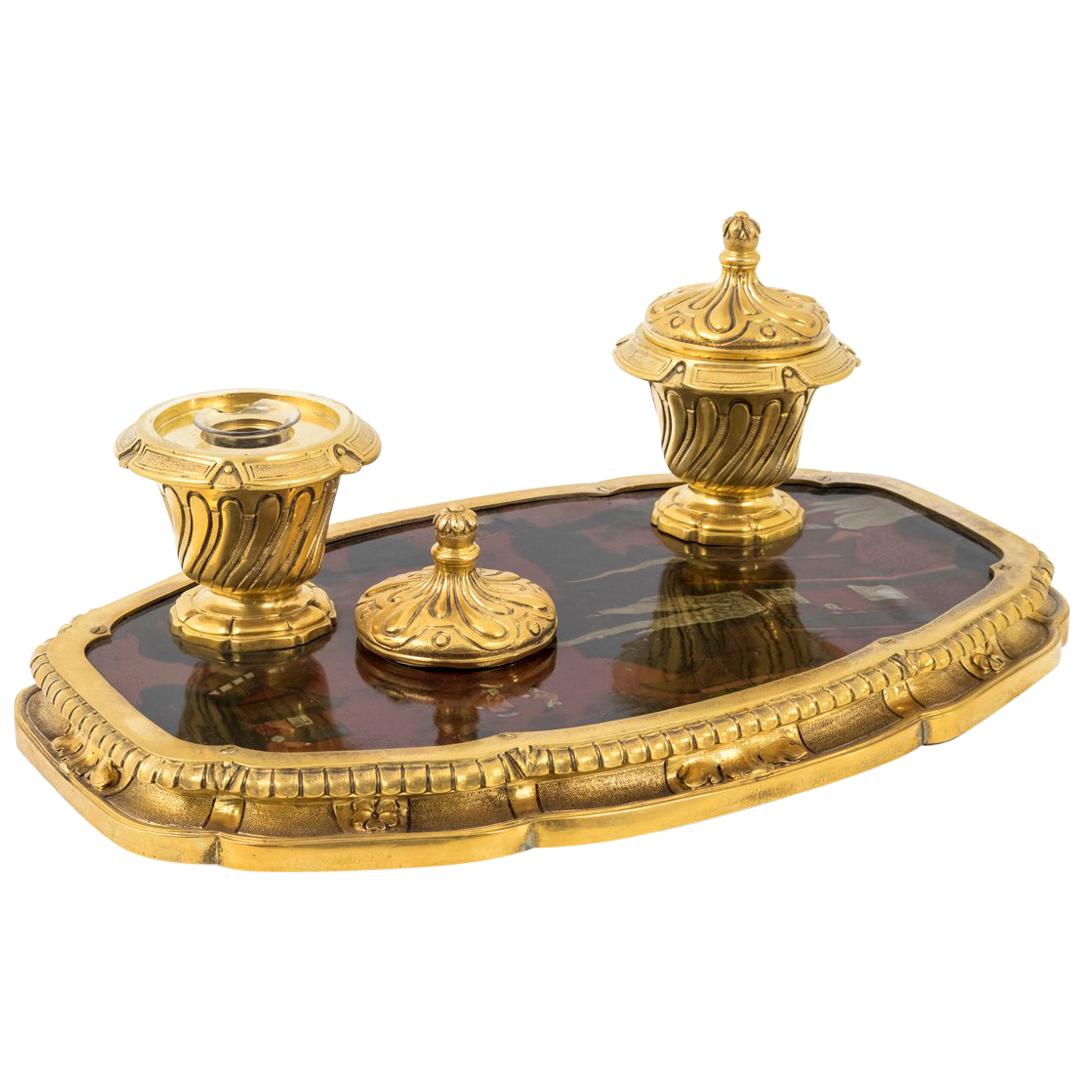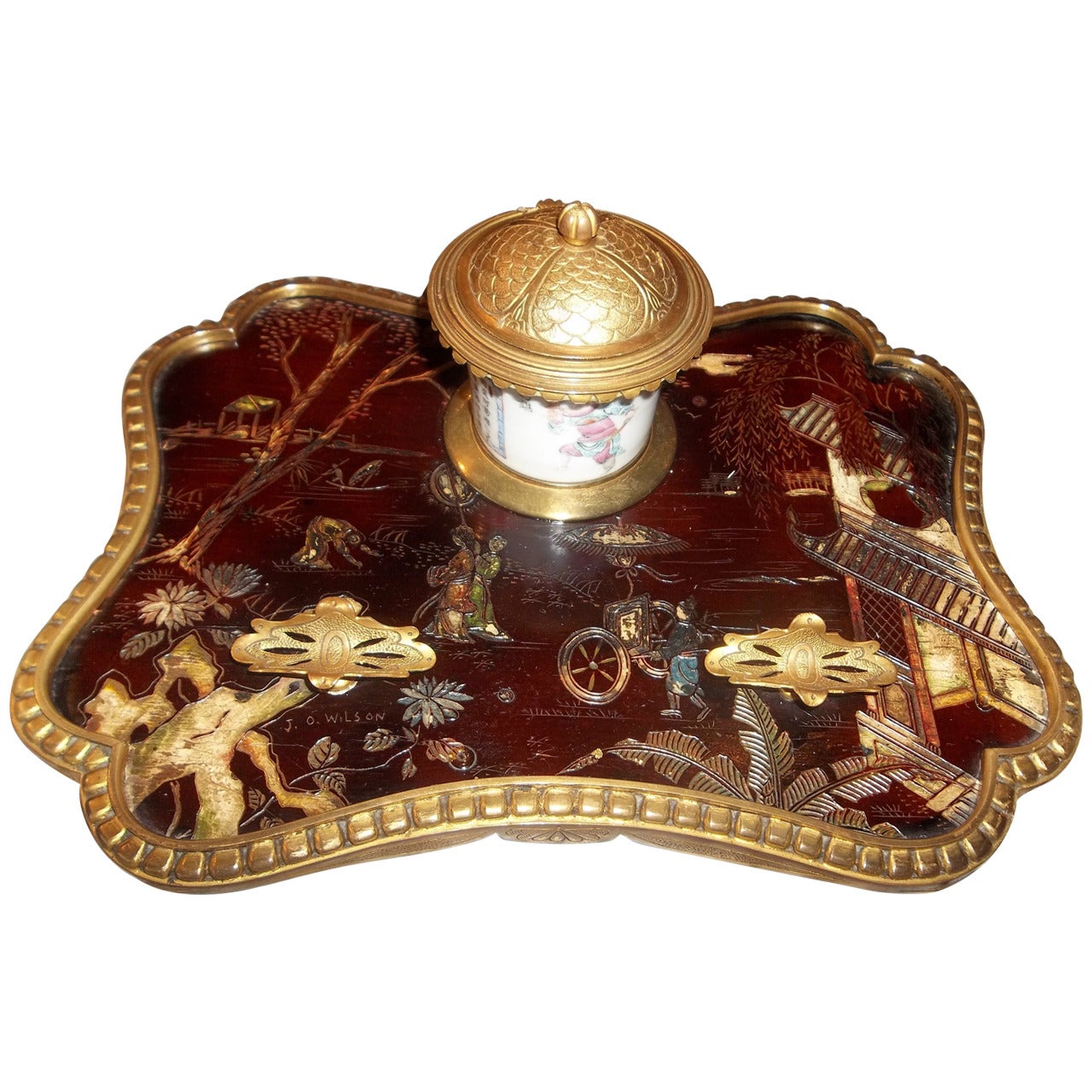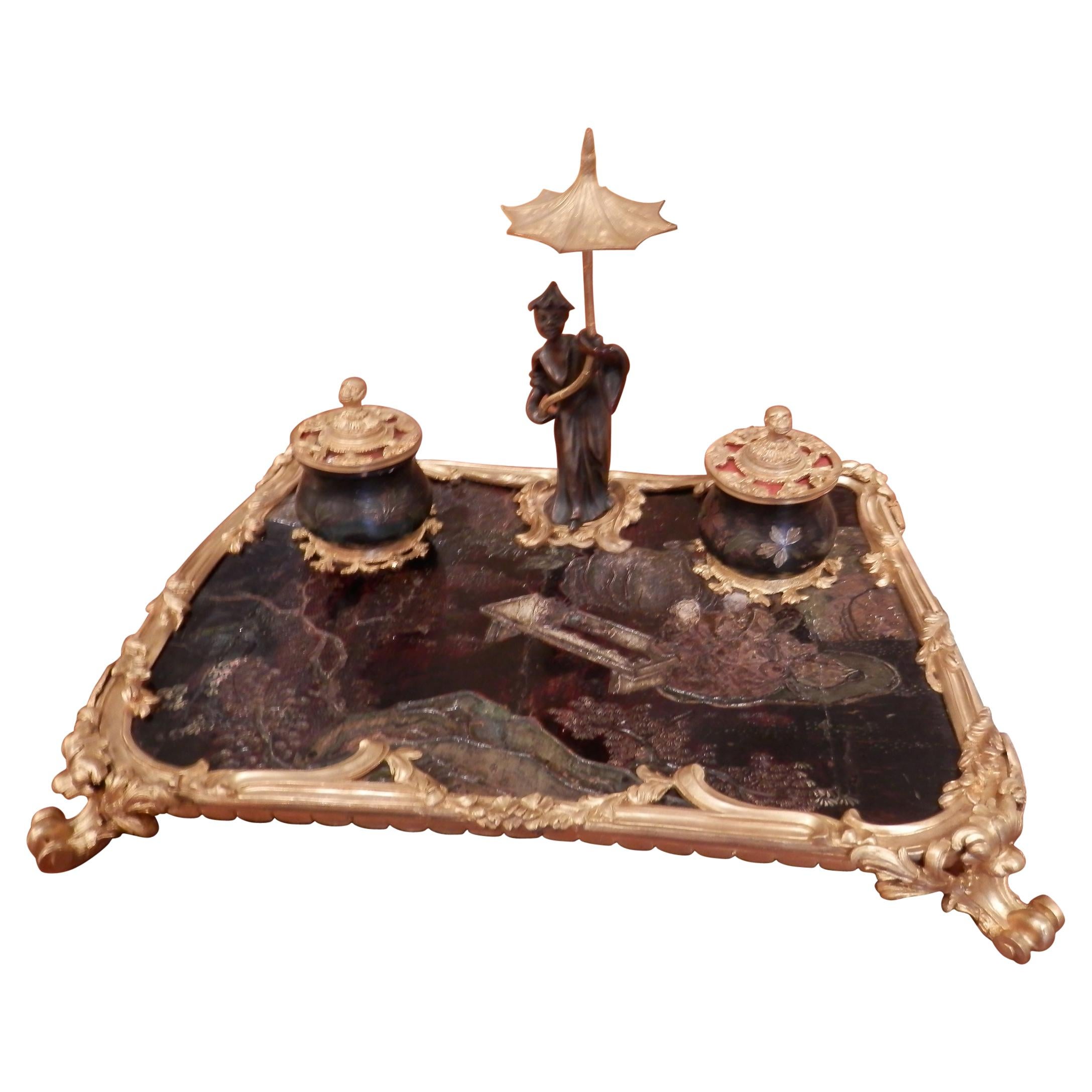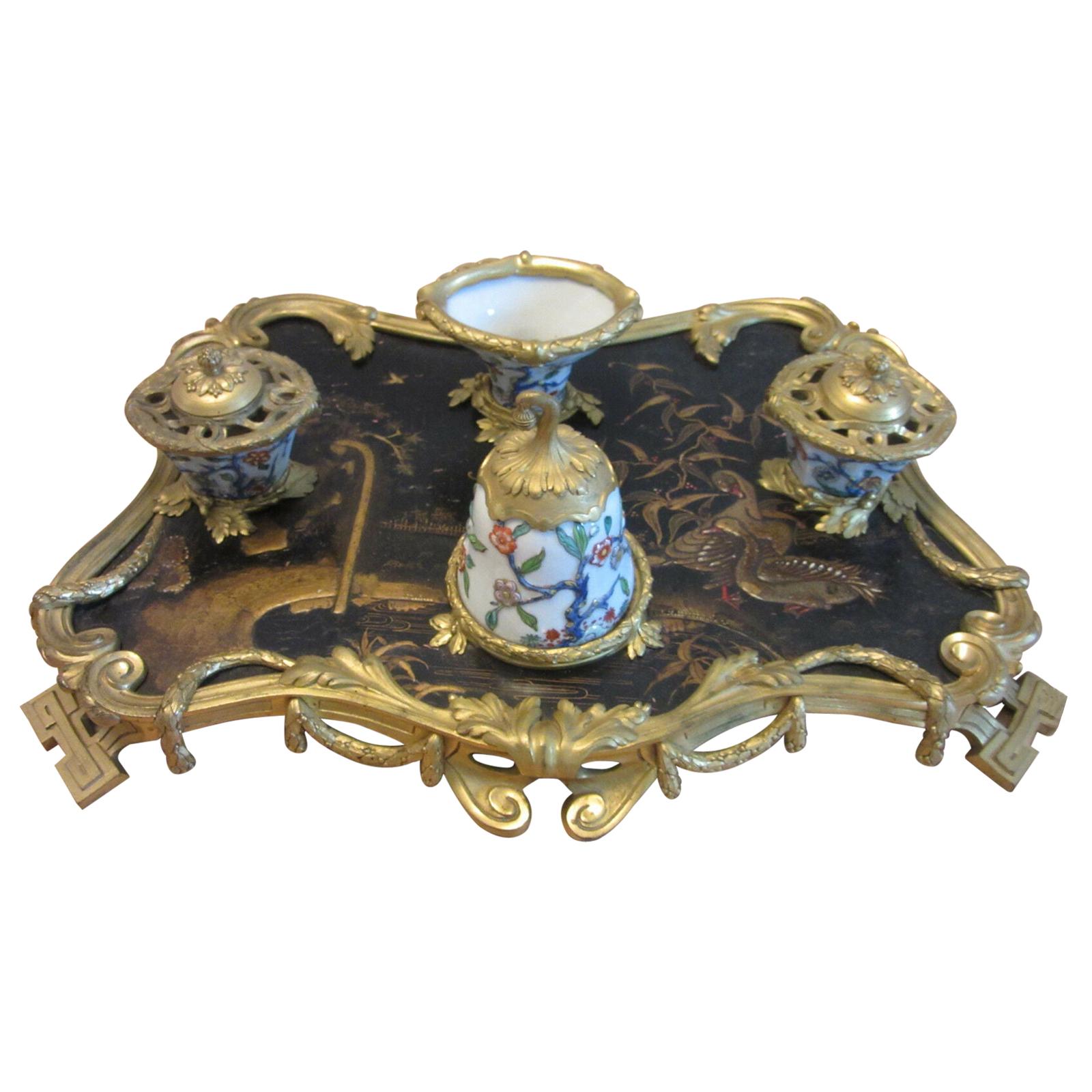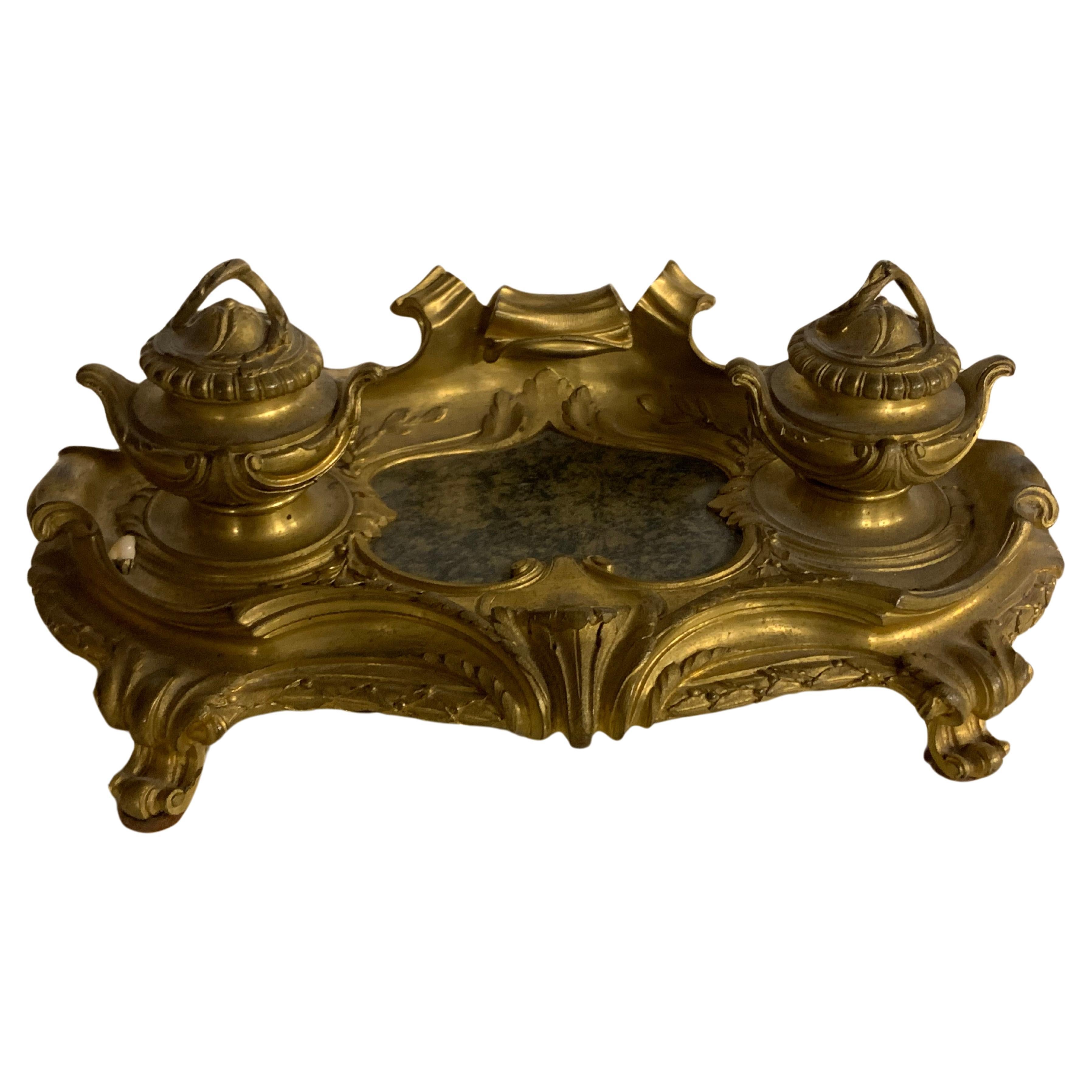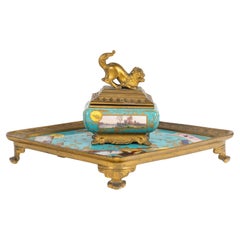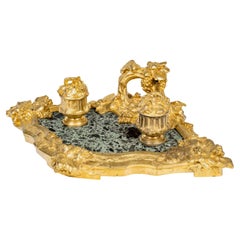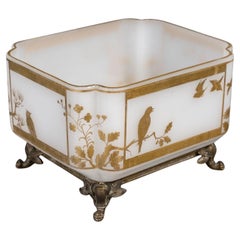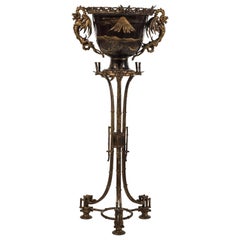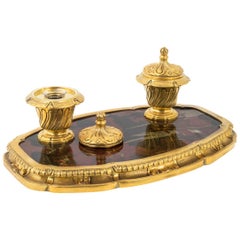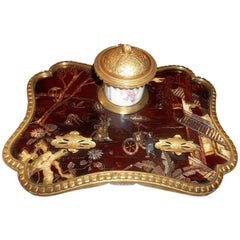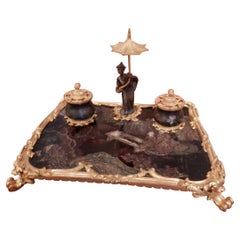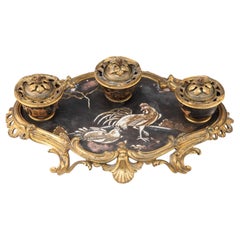Items Similar to An Ormolu and Coromandel Lacquer Inkwell, circa 1880
Want more images or videos?
Request additional images or videos from the seller
1 of 10
An Ormolu and Coromandel Lacquer Inkwell, circa 1880
$1,849.01
£1,367
€1,550
CA$2,543.29
A$2,827.02
CHF 1,481.87
MX$34,524.80
NOK 18,500.23
SEK 17,405.27
DKK 11,800.12
About the Item
An Ormolu and Coromandel Lacquer Inkwell, circa 1880
Chiseled and gilded bronze inkwell composed of a chantered shape tray in Coromandel lacquer, moulded edge in chiselled and gilded bronze, resting on three feet.
Lacquer tray with chinoisant design of shrubs, pagoda, bird and characters on which are fixed two ormolu tanks in the form of covered pots
Louis XV style
Circa 1880
The aesthetic of Chinoiserie has been expressed in different ways depending on the region. Its acknowledgement derives from the current of Orientalism, which studied Far East cultures from a historical, philological, anthropological, philosophical, and religious point of view. First appearing in the 17th century, this trend was popularized in the 18th century due to the rise in trade with China and the rest of East Asia.
As a style, chinoiserie is related to the Rococo style.
Both styles are characterized by exuberant decoration, asymmetry, a focus on materials, and stylized nature and subject matter that focuses on leisure and pleasure. Chinoiserie focuses on subjects that were thought by Europeans to be typical of Chinese culture.
There were many reasons why chinoiserie gained such popularity in Europe in the 18th century. Europeans had a fascination with Asia due to their increased, but still restricted, ac-cess to new cultures through expanded trade with East Asia, especially China. The 'China' indicated in the term 'Chinoiserie' represented in European people's mind a wider region of the globe that could embrace China itself, but also Japan, Korea, South-East Asia, India or even Persia. In art, the style of "the Orient" was considered a source of inspiration; the atmosphere rich in images and the harmonic designs of the oriental style reflected the picture of an ideal world, from which to draw ideas in order to reshape one own's culture. For this reason, the style of Chinoiserie is to be regarded as an important result of the exchange be-tween the West and the East. During the 19th century, and especially in its latter period, the style of Chinoiserie was assimilated under the generic definition of exoticism.
Chinoiserie persisted into the 19th and 20th centuries but declined in popularity. There was a notable loss of interest in Chinese-inspired décor after the death in 1830 of King George IV, a great proponent of the style. The First Opium War of 1839–1842 between Britain and China disrupted trade and caused a further decline of interest in the Oriental.China closed its doors to exports and imports and for many people chinoiserie became a fashion of the past.
As British-Chinese relations stabilized towards the end of the 19th century, there was a revival of interest in chinoiserie. Prince Albert, for example, reallocated many chinoiserie works from George IV's Royal Pavilion at Brighton to the more accessible Buckingham Palace. Chinoiserie served to remind Britain of its former colonial glory that was rapidly fading with the modern era.
- Similar to:L'Escalier de Cristal (Maker)
- Dimensions:Height: 3.75 in (9.5 cm)Width: 8.08 in (20.5 cm)Depth: 5.71 in (14.5 cm)
- Style:Chinoiserie (In the Style Of)
- Materials and Techniques:
- Place of Origin:
- Period:
- Date of Manufacture:circa 1875
- Condition:Wear consistent with age and use.
- Seller Location:Saint-Ouen, FR
- Reference Number:1stDibs: LU2612344421442
About the Seller
4.8
Vetted Professional Seller
Every seller passes strict standards for authenticity and reliability
1stDibs seller since 2017
68 sales on 1stDibs
Typical response time: <1 hour
- ShippingRetrieving quote...Shipping from: Saint-Ouen, France
- Return Policy
Authenticity Guarantee
In the unlikely event there’s an issue with an item’s authenticity, contact us within 1 year for a full refund. DetailsMoney-Back Guarantee
If your item is not as described, is damaged in transit, or does not arrive, contact us within 7 days for a full refund. Details24-Hour Cancellation
You have a 24-hour grace period in which to reconsider your purchase, with no questions asked.Vetted Professional Sellers
Our world-class sellers must adhere to strict standards for service and quality, maintaining the integrity of our listings.Price-Match Guarantee
If you find that a seller listed the same item for a lower price elsewhere, we’ll match it.Trusted Global Delivery
Our best-in-class carrier network provides specialized shipping options worldwide, including custom delivery.More From This Seller
View All19th Century French Japonisme Inkwell attributed to L'Escalier de Cristal
By L'Escalier de Cristal
Located in Saint-Ouen, FR
A very nice quality French Japonisme Style inkwell
Attributed to l'Escalier de Cristal, circa 1880
Resting on a diamond-shaped polychromed hand-painted porcelain tray representing l...
Category
Antique Late 19th Century French Japonisme Inkwells
Materials
Ormolu
Albert Marionnet (1852-1910), A Belle Époque Naturalistic Inkwell, circa 1900
By Albert Marionnet
Located in Saint-Ouen, FR
Albert Marionnet (1852-1910),
A Large Belle-Epoque Naturalistic Inkwell, circa 1900
In gilded and chiseled bronze with naturalistic decoration of grapevines, the green marble board ...
Category
Antique 1890s French Belle Époque Inkwells
Materials
Marble, Ormolu
Japonisme Ormolu-Mounted Opaline Jardiniere by Maison Baccarat, circa 1865
By Baccarat
Located in Saint-Ouen, FR
Japonisme Ormolu-Mounted Opaline Jardiniere by Maison Baccarat, circa 1865
A French Japonisme rectangular shape with double lobed corners Jardiniere
White Opaline glass with gold han...
Category
Antique 1860s French Japonisme Planters, Cachepots and Jardinières
Materials
Ormolu
French Japonisme Lacquered Metal Jardinière on Ormolu Stand Signed Marnyhac
By Edouard Lievre, Maison Marnyhac 1
Located in Saint-Ouen, FR
Jardinière Médicis vase shape in copper with gold lacquered decoration on a burgundy background of a Japanese landscape with a volcano and an eagle ...
Category
Antique 1870s French Japonisme Planters, Cachepots and Jardinières
Materials
Metal, Bronze
A French 19th Century Pot-Pourri Covered Vase
Located in Saint-Ouen, FR
A French 19th Century Pot-Pourri Covered Vase
Large pot-pourri covered and ormolu-mounted ceramic vase
Resting on an ormolu base simulating a perfume burner with posts in claws.
L...
Category
Antique 1860s French Louis XVI Vases
Materials
Ormolu
$3,578 Sale Price
33% Off
A Louis XV Style Desk Travelling Cartel Clock circa 1875
By Etienne LeNoir
Located in Saint-Ouen, FR
Desk Travelling Cartel Clock in chiseled and gilded bronze
Rocaille decoration of scrolls, acanthus leaves and lyre
Enamel dial signed Lenoir in Paris
Plate mechanism No. 13287 and w...
Category
Antique 1870s French Louis XV Carriage Clocks and Travel Clocks
Materials
Enamel, Ormolu
You May Also Like
Gilt Bronze Inkwell with Chinese Style Lacquer, Late 19th Century
Located in Saint-Ouen, FR
Chiselled and gilt bronze inkwell made of with a scalloped red lacquer tray with a moulded gilt bronze edge with a decor of gadroons, flowers and foliage. Chinese style red lacquer t...
Category
Antique Late 19th Century European Chinoiserie Scholar's Objects
Materials
Bronze
Japanned or Chinoiserie Decorated Louis XV Style Lacquer Inkwell
Located in Nashville, TN
The lacquer ground with a strong burgundy undertone. Well carved , colored and other wise decorated . The porcelain well in good Antique condition . Minor wear due to age and use .
Category
Antique 1860s French Louis XV Inkwells
Materials
Lacquer
Very Large and Fine 19th Century Chinoiserie and Gilt Bronze Inkwell
Located in Dallas, TX
A very fine 19th century French Chinoiserie and gilt bronze inkwell with a decorated scene. Fine gilt bronze detail with a patinated Oriental figure in the center and inkpots with mo...
Category
Antique Late 18th Century French Chinoiserie Inkwells
Materials
Bronze
Period French Louis XV Ormolu Mounted Japanese Lacquer Chinoiserie Inkwell Tray
By Vernis Martin
Located in Forney, TX
A scarce nearly 300 year old Louis XV (1715-1774) period French gilt bronze ormolu mounted Japanned encrier (inkwell or inkstand)
Paris, France, circa 1750, exceptionally executed in Louis 14th exotic far-east Japanesque / Chinoiserie oriental styling, popular at the time due to the rise in trade with China and Japan throughout the 18th century, Parisian Vernis Martin lacquer work, decorated with lavish Rocaille elements, having three inkwells fitted with glass jar inserts and ornate fiolated acorn finial covers, on a black lacquer cartouche shaped tray with roster...
Category
Antique Mid-18th Century French Louis XV Inkwells
Materials
Bronze, Ormolu
Fine and Rare Large 19th C Chinoiserie Inkwell with Porcelain Bell and Ink Pot
Located in Dallas, TX
A fine and large 19th century Chinoiserie inkwell with raised decoration and fine gilt bronze mounts. Porcelain inkpots and a porcelain bell.
Category
Antique Late 19th Century French Chinoiserie Inkwells
Materials
Bronze
19th Century French accessories Inkwell in bronze Louis XV style
Located in Los Angeles, CA
Louis XV style bronze inkwell ,in the middle you have a marble plaque in the shape of a heart ,the bronze are finely executed,original condition
Extremly rare this inkwell have its...
Category
Antique 1890s French Louis XV Inkwells
Materials
Bronze
More Ways To Browse
British Antique China
Desk With Birds
Coromandel Furniture
Chinese Ormolu
Royal Pavilion
Brown Coromandel
Antique Lacquer Desk
Coromandel Wood
Japanese Desk Modern
Antique Chinese Desk
Expanding Desk
Exotic Wood Desk
Brighton Style
Japanese Wood Desk
Chinese Wood Desk
Antique Japanese Desk
Used Trading Desk
Oriental Door
